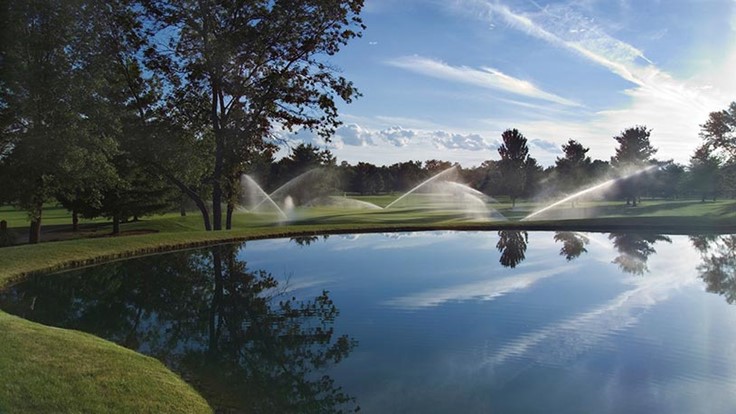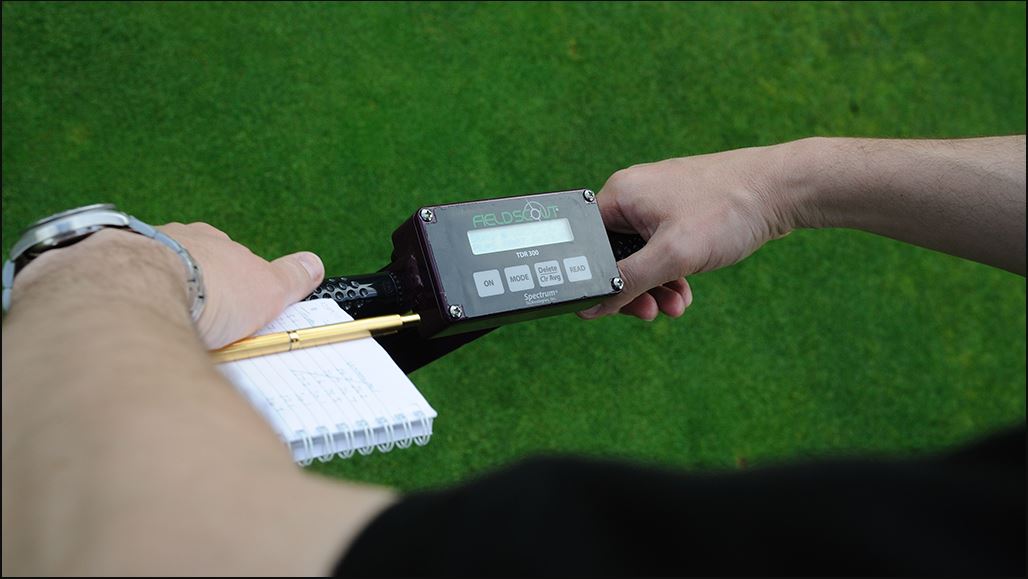Many of us take the stunning view of a properly maintained golf course for granted. Often golf courses have large areas of perfectly formed grass which does not just happen by chance. A lot of this comes down to the irrigation systems that are implemented.
Irrigation is ‘the supply of water to land or crops to help growth, typically by means of channels’. When you apply this definition to a golf course, you start to understand that it plays an important role in the growth of health turf which can be maintained by course managers and greenkeepers.
Although it may sound simple, irrigation is a science more complex than most people realise.
Components Of A Golf Course Irrigation System

1. Water Sources
18-hole golf courses can sometimes require 2,000 gallons of water per minute, highlighting the importance of having a consistent water supply. There are multiple water sources that a golf course irrigation system can use:
- Surface Water
- Ground Water
- Potable
- Effluent
Each water source has it pros and cons but they are often used in combination to eliminate the negatives.
Surface water is stored in lakes and ponds. Rainwater will drain into these storage areas ready for the irrigation system to use. Surface water is often the preferred water source because it is seen as a sustainable supply since you are recycling rainwater. Although it can be difficult to solely rely on surface water because rain isn’t available on demand.
Groundwater can be sourced from underground wells where the water is pumped into a reservoir or onsite ponds where it can be stored.
Potable water comes directly from mains water supplies and can be seen as a reliable supply because you can access it when required. Although potable water should be seen as a last resort, not only because it’s expensive but because it isn’t a sustainable water source. Using potable water puts constraints on national and local water supplies.
Effluent water comes directly from sewage waste. This can be filtered and treated to be reused within an irrigation system. It can be costly setting this up and will generally only use greywater produced from the golf club which can also be in limited supply.
Read about how golf clubs can use water more sustainably HERE
2. Pump Station
The next stage of a golf course irrigation system is the pump station. This will be installed in ponds or within onsite tanks where there are large amounts of stored water.
The pump pulls water from the source and pushes it through a network of underground pipes. The pump station will only feed the pipes with water when it is needed.
3. Water Distribution System
Water needs to be delivered to key areas of the golf course and this can be achieved through a network of pipes. These pipes are often referred to as arterial pipes because they resemble a network of arteries.
Larger pipes are situated at the pump station and throughout the golf course with smaller pipes branching off to areas where it is needed.
4. Control Valves
Valves look to control the release of water either into distribution lines or into different valves. These valves can be manually or remotely operated depending on the sophistication of the system installed.
If you are using a remote system with hydraulic switches, these valves are controlled using remote computer software.
5. Control Lines
The control lines are installed along with pipes which connects the system to irrigation software.
These lines allow the taps & valves to be turned on & off as and when water is to be dispersed under pressure via sprinklers.
6. Sprinkler Head
Golf course irrigation systems usually utilise rotary and pop-up sprinklers which deliver the required amount of water to specific areas of a golf course. They have 360 degrees of turn for effective irrigation.
When should a golf course use its irrigation system?

Too often golf courses use their irrigation system when they do not need to. For example, in summer you expect to use more water, however this shouldn’t be the final indication when to use the system. Data should be analysed on the following key indicators:
- Soil Moisture
- Temperature
- Evapotranspiration Rate (ET Rate)
- Weather Forecast i.e. Rainfall
Installing sensors would be smart at this stage as it can gather data on some of the indicators. Irrigation software can then autonomously decide when and where to irrigate or it can be configured by a course management team. Constant monitoring should be undertaken to ensure over or under irrigation does not take place.
In general you should look to irrigate in the morning when it is cooler and there is less wind. Watering in the afternoon, especially in warmer weather, is not a good idea because water can evaporate before it is absorbed meaning your turf won’t be getting the water it needs.
Sources:
Your Golf Course Irrigation Guide | Golf Irrigation (dte.golf)